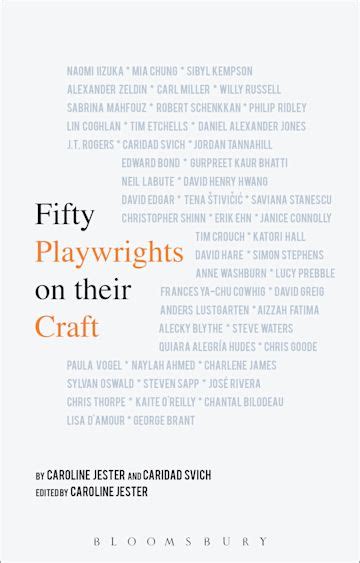| Kaite O'Reilly, David Greig, Simon Stephens: Among the Dramatists |
Theatre Writer Book |
| Fifty Playwrights on Their Craft- Caroline Jester & Caridad Svich , Bloomsbury Books , October 9, 2025 |
 Many playwrights have written valuable analyses of their chosen art form. David Edgar, Steve Gooch, Stephen Jeffries all feature below.
Many playwrights have written valuable analyses of their chosen art form. David Edgar, Steve Gooch, Stephen Jeffries all feature below. The editors of this compendium add to the genre with names of a newer generation. They also cross the Atlantic to catch members of the group who have been produced in the last decade. Memorable plays by Annie Baker, Branden Gough Jacobs, J T Rogers, Bruce Norris, Cary Crim, Neil Labute and Christopher Shinn have all been seen in London. Other names are less familiar: Quiara Alegria, Jose Rivera, Naomi Iizuka, Frances Ya- Chu Cowhig, Katori Hall, Chantal Bilodeau from Canada. Names from this side of the Atlantic include Steve Waters, Alecky Blythe, Chris Thorpe, Alexander Zeldin, Tom Etchells, Anders Lustgarten, Lucy Prebble, Tim Crouch, Gurpreet Kaur Bhatti. Kaite O'Reilly features over five pages, topics including “Peeling” and “In water I'm Weightless.” In answer to “What is a playwright?” she gives a reply of richness. “...I'll always say a playwright, in my definition, from my experience, who writes the invisible; we write the invisible, we write structure, we write dramaturgy, we write atmosphere, we write dynamic, we write tempo, we write pace, we write subtext, we write everything that you can't tangibly see on the page necessarily, but you can see when it goes into live medium, performed by other people. “So a playwright writes the invisible and does all those things, that are, I think, structural. I think they are to do with energy and energetic, the ephemeral and being in the moment, but when it's translated with the imaginations and skills of the rest of the company, the directors, the scenographers, the designers, the actors...that's what I think a playwright creates- the invisible thing that we then see when we work with our collaborators.” * * * * On page 72: “I always think of myself as a composer...I'm thinking of the textual, variety, the unexpected. I'm thinking of the movement of the language and the action, the dramatic action...I don't play an instrument, but I think it's similar to the way a composer thinks about writing music, it's moving, it's dynamic.” On page 73 the relationship between maker and see-er: “It's not that I'm thinking of the audience as a way of inflicting ideas or perspectives or political aspects on them.” On page 75: “I like to think that theatre is the exploration of what it is to be human and I try in my work to embrace all the possibilities of human variety.” In answer to “How do playwriting and the playwright fit into the digital age of story-telling?” “I don't know...I'm not quite sure what digital storytelling is, or the digital age. I do a lot with video, with different theatre languages, with projected texts, with soundscapes...I don't really know what the phrase means.” * * * * The book is divided into five sections. They are “Where Do Ideas Come From and How Do They Begin Their Transformation Into Plays?”, “How Do You Put It All Together?”, “Don't Put Me in a Box”, “I can Pass Through Any Border” and “What Are You Responsible For?” A lead practitioner in Scotland is asked: “Structure informs narrative and narrative informs structure, but how can the stage, whatever form that takes, inform the playwright's creative process?” David Greig: I don't know because I don't quite understand the question. And on page 111: “The playwright crafts drama unmediated by screens. The theatre is the last unmediated public space. It's the place we gather together, next to each other, no phones or screens, and we watch the unfolding of life through time. The playwright is the person who organises this. "So long as we yearn for common experience- and we do, witness the increasing need for live events- we will have a place for playwrights, because they structure these events for us in such a way as provokes emotion, thought, catharsis. The digital age is no more of a threat to theatre than every age since 2500 BC...from Rome to Ford to the internet...theatre is a basic human need.” * * * * On page 196: David Hare: “We're no different from painters. We can't choose our subject matter. It chooses us. Photographers say something is photogenic, but they can't say why. It's mysterious.. * * * * And Simon Stephens: “I think the noun contains the two most important functions of the job. Second part first. We are “wrights” not “writers”. We have wrought our plays, not written them, like a shipwright has wrought a ship or a cartwright a cart. Our work is to shape or make a piece of theatre, not to write down words. It's also key that we are making plays; we are making playthings. Our work is to create play and the energy and anarchy and disorder and creativity that play incorporates.” A guide to the sequence on playwrights and dramatists can be read in the first link below. |
Reviewed by: Adam Somerset |
This review has been read 103 times There are 34 other reviews of productions with this title in our database:
|
